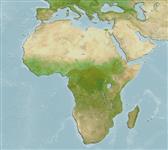Classification / Names
Common names | Synonyms | Catalog of Fishes (gen., sp.) | ITIS | CoL | WoRMS | Cloffa
Actinopterygii (ray-finned fishes) >
Siluriformes (Catfish) >
Amphiliidae (Loach catfishes) > Doumeinae
Etymology: inga: River; a noun in apposition (Ref. 88958). More on author: Vari.
Environment / Climate / Range
Ecology
Freshwater; demersal. Tropical, preferred ?; 5°S - 6°S, 13°E - 14°E
Africa: known only from the vicinity of the Inga Dam, Lower Congo River basin, in the Democratic Republic of the Congo (Ref. 88958, 92838).
Size / Weight / Age
Maturity: Lm ? range ? - ? cm
Max length : 11.1 cm SL male/unsexed; (Ref. 88958)
Short description
Morphology | Morphometrics
Dorsal
spines
(total): 0;
Dorsal
soft rays
(total): 7-8;
Anal
spines: 0;
Anal
soft rays: 10 - 11;
Vertebrae: 35 - 37. Diagnosis: Congoglanis inga differs from C. sagitta in having a longer maxillary barbel, reaching well past vertical through anterior margin of orbit vs. not reaching to orbit; a deeper caudal peduncle, 7-8% of standard length vs. 6%; and less slender caudal peduncle, its depth 2.1-2.9 times in its length vs. 3.1-4.0; a longer pelvic fin, 22-25% of standard length vs. 19-21%; a more posteriorly placed anal fin, anal-fin origin approximately at tip of adpressed pelvic fin vs. origin well in advance of tip of adpressed pelvic fin; longer anal-fin rays, posterior rays of adpressed anal fin extend well past vertical through posterior limit of adipose fin vs. posterior rays extend to vertical through posterior limit of adipose fin; and fewer vertebrae, 35-37 vs. 39-41 (Ref. 88958). It differs from C. alula in having a longer maxillary barbel, reaching well past vertical through anterior margin of orbit vs. not reaching the orbit; a shorter pelvic fin, 19-21% of standard length vs. 24-28%; a longer postorbital length, 32-35% of head length vs. 27-31%; a relatively wide interorbital width, 2 times eye-diameter vs. 1.5 times; and longer anal-fin rays, posterior rays of adpressed anal fin extend well past vertical through posterior limit of adipose fin vs. posterior rays extend to vertical through posterior limit of adipose fin (Ref. 88958).
Specimens have been collected from "a long channel with moderate current, numerous pools and a predominantly rocky bottom" (Ref. 42510, 88958).
Life cycle and mating behavior
Maturity | Reproduction | Spawning | Eggs | Fecundity | Larvae
Ferraris, C.J. Jr., R.P. Vari and P.H. Skelton, 2011. A new genus of African loach catfish (Siluriformes: Amphiliidae) from the Congo River basin, the sister-group to all other genera of the Doumeinae, with the description of two new species. Copeia 2011(4):477-489. (Ref. 88958)
IUCN Red List Status (Ref. 115185)
CITES (Ref. 94142)
Not Evaluated
Threat to humans
Harmless
Human uses
Fisheries:
More information
Common namesSynonymsMetabolismPredatorsEcotoxicologyReproductionMaturitySpawningFecundityEggsEgg development
Age/SizeGrowthLength-weightLength-lengthLength-frequenciesMorphometricsMorphologyLarvaeLarval dynamicsRecruitmentAbundance
ReferencesAquacultureAquaculture profileStrainsGeneticsAllele frequenciesHeritabilityDiseasesProcessingMass conversion
Tools
Special reports
Download XML
Internet sources
